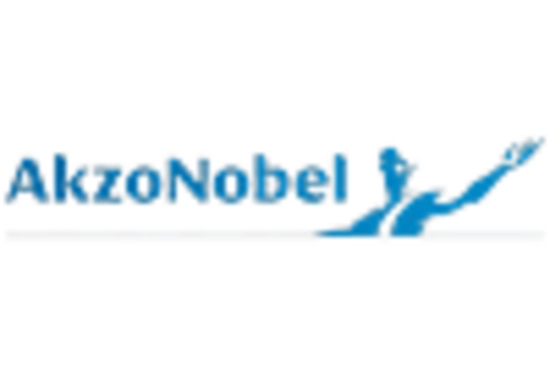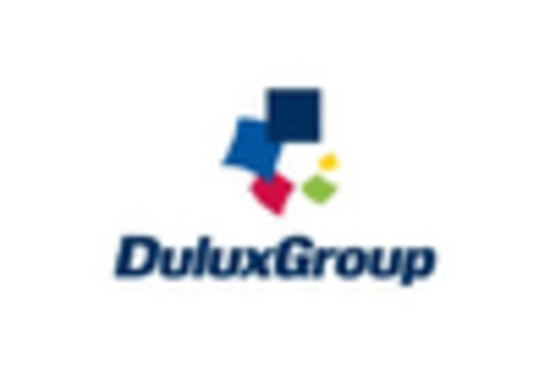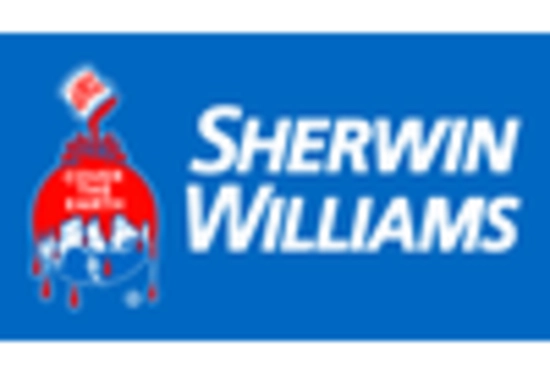Regulatory Compliance
Regulatory compliance is a crucial factor influencing the Water Borne Inks Paint Market. Governments worldwide are implementing stringent regulations aimed at reducing environmental impact and promoting the use of low-emission products. These regulations often mandate the reduction of VOCs in inks and paints, thereby driving manufacturers to adopt water borne inks as a compliant alternative. The increasing enforcement of environmental standards is likely to accelerate the transition from solvent-based to water borne inks, as companies seek to avoid penalties and enhance their market positioning. This regulatory landscape not only fosters innovation but also encourages the development of safer, more sustainable products. As a result, the Water Borne Inks Paint Market is expected to expand, with a growing number of manufacturers aligning their offerings with regulatory requirements.
Technological Innovations
Technological advancements are reshaping the Water Borne Inks Paint Market, driving efficiency and product quality. Innovations in formulation chemistry have led to the development of high-performance water borne inks that offer superior adhesion, durability, and color vibrancy. These advancements enable manufacturers to meet the evolving demands of various applications, including packaging, textiles, and industrial coatings. Furthermore, the integration of digital printing technologies has revolutionized the market, allowing for more precise and customizable printing solutions. As a result, the market is witnessing a shift towards more sophisticated ink formulations that cater to specific customer needs. The continuous investment in research and development is expected to propel the growth of the Water Borne Inks Paint Market, with an anticipated increase in market share for technologically advanced products.
Sustainability Initiatives
The increasing emphasis on sustainability appears to be a primary driver for the Water Borne Inks Paint Market. As consumers and businesses alike become more environmentally conscious, the demand for eco-friendly products rises. Water borne inks, which utilize water as a solvent, significantly reduce volatile organic compounds (VOCs) compared to traditional solvent-based inks. This shift aligns with regulatory pressures and consumer preferences for sustainable solutions. In fact, the market for water borne inks is projected to grow at a compound annual growth rate (CAGR) of approximately 5% over the next few years, reflecting a broader trend towards sustainable practices in various industries. Companies that prioritize sustainability in their product offerings are likely to gain a competitive edge in the Water Borne Inks Paint Market.
Market Demand for Versatility
The demand for versatility in applications is a significant driver of the Water Borne Inks Paint Market. Industries such as packaging, automotive, and textiles are increasingly seeking inks that can perform across a variety of substrates and conditions. Water borne inks are particularly appealing due to their adaptability, allowing for use on diverse materials while maintaining high-quality output. This versatility is essential in a market that values customization and rapid production cycles. As businesses strive to meet consumer expectations for unique and varied products, the demand for water borne inks is likely to rise. The ability to cater to multiple applications positions the Water Borne Inks Paint Market favorably for growth, as manufacturers respond to the evolving needs of their clients.
Consumer Preferences for Healthier Options
Consumer preferences are shifting towards healthier and safer options, which is significantly impacting the Water Borne Inks Paint Market. As awareness of the potential health risks associated with traditional solvent-based inks increases, consumers are actively seeking alternatives that pose fewer health hazards. Water borne inks, known for their lower toxicity and reduced emissions, are becoming the preferred choice for both consumers and manufacturers. This trend is particularly evident in sectors such as food packaging and children's products, where safety is paramount. The growing inclination towards health-conscious products is likely to drive the expansion of the Water Borne Inks Paint Market, as companies adapt their offerings to align with consumer demands for safer, more environmentally friendly solutions.


















Leave a Comment